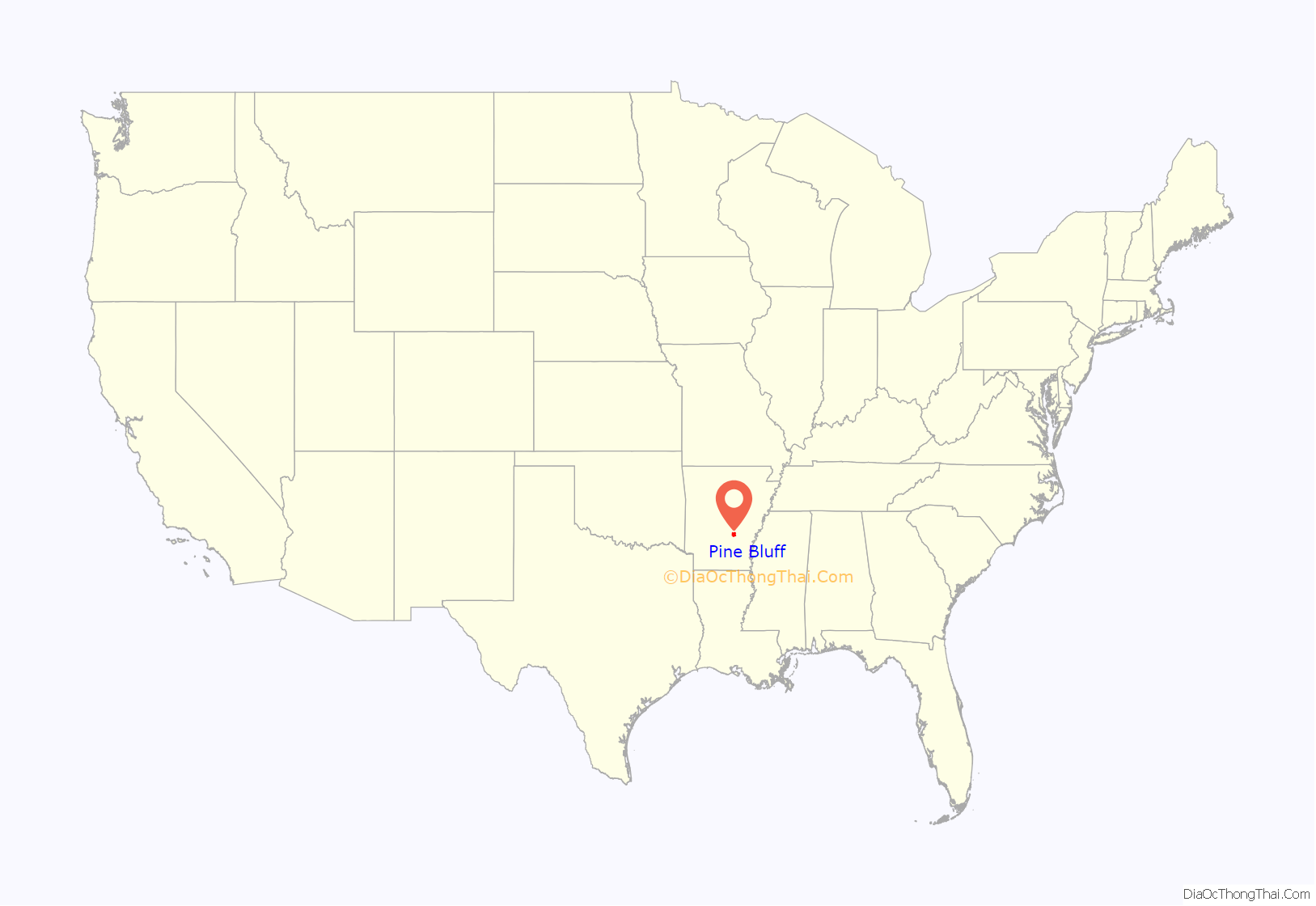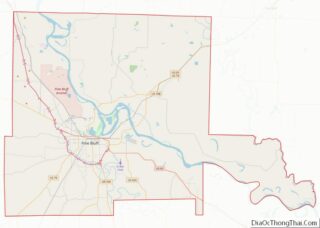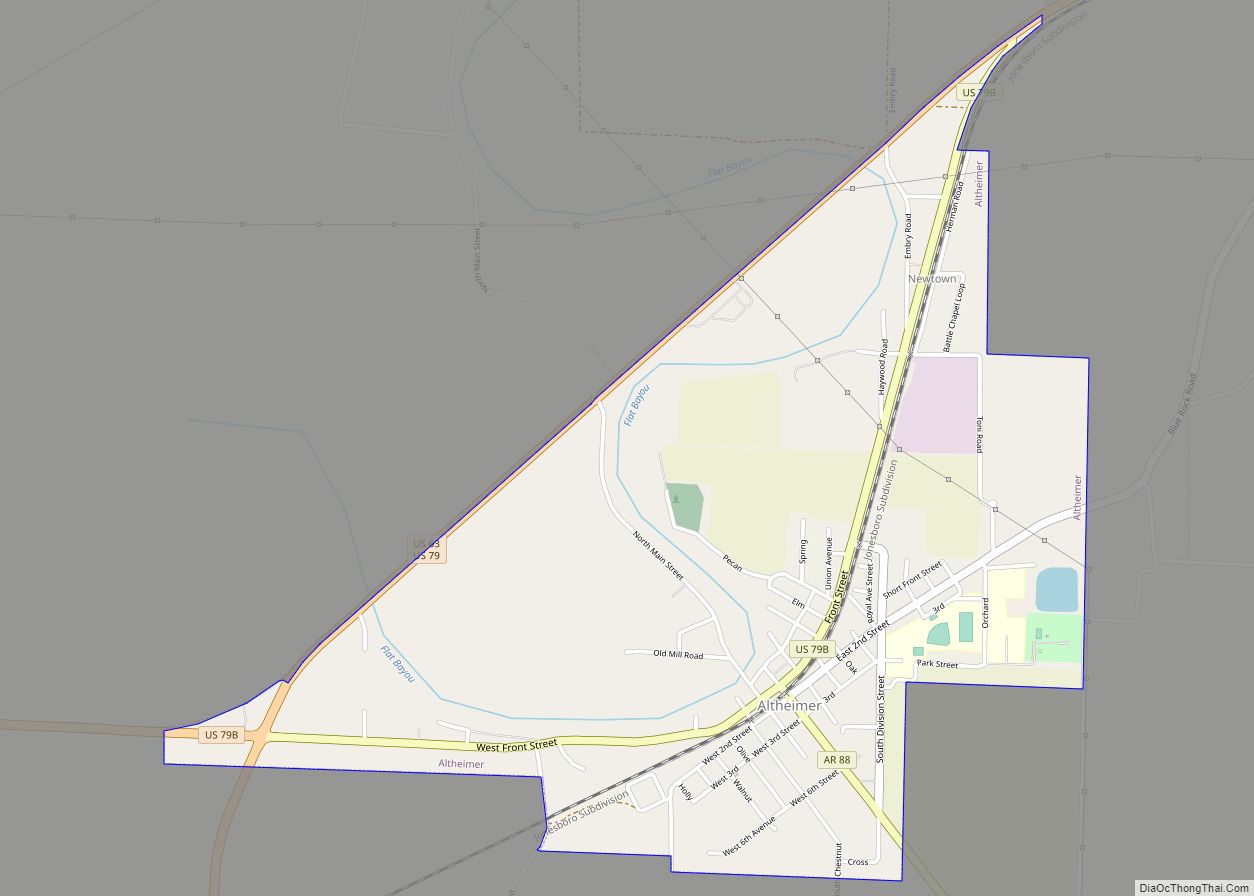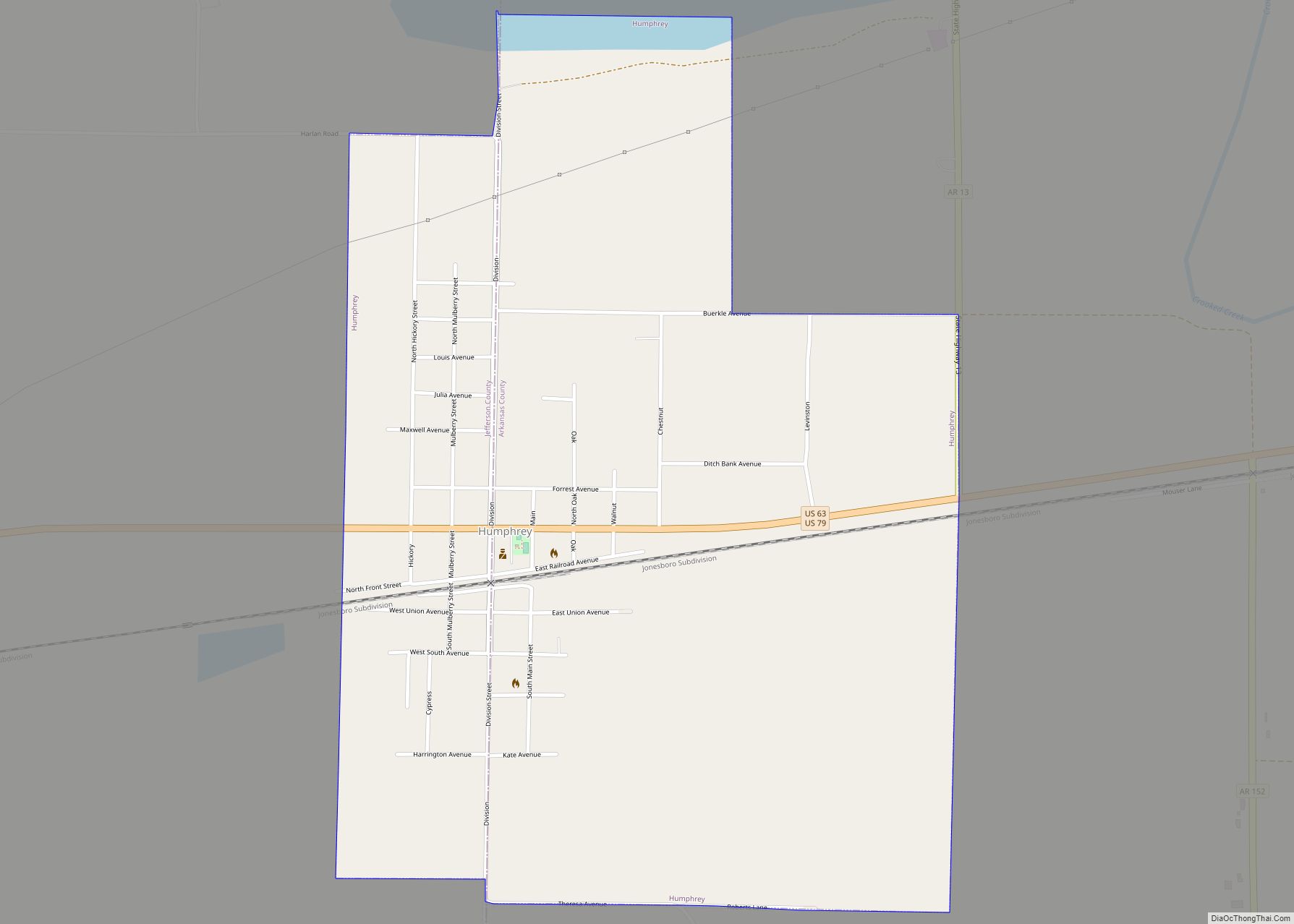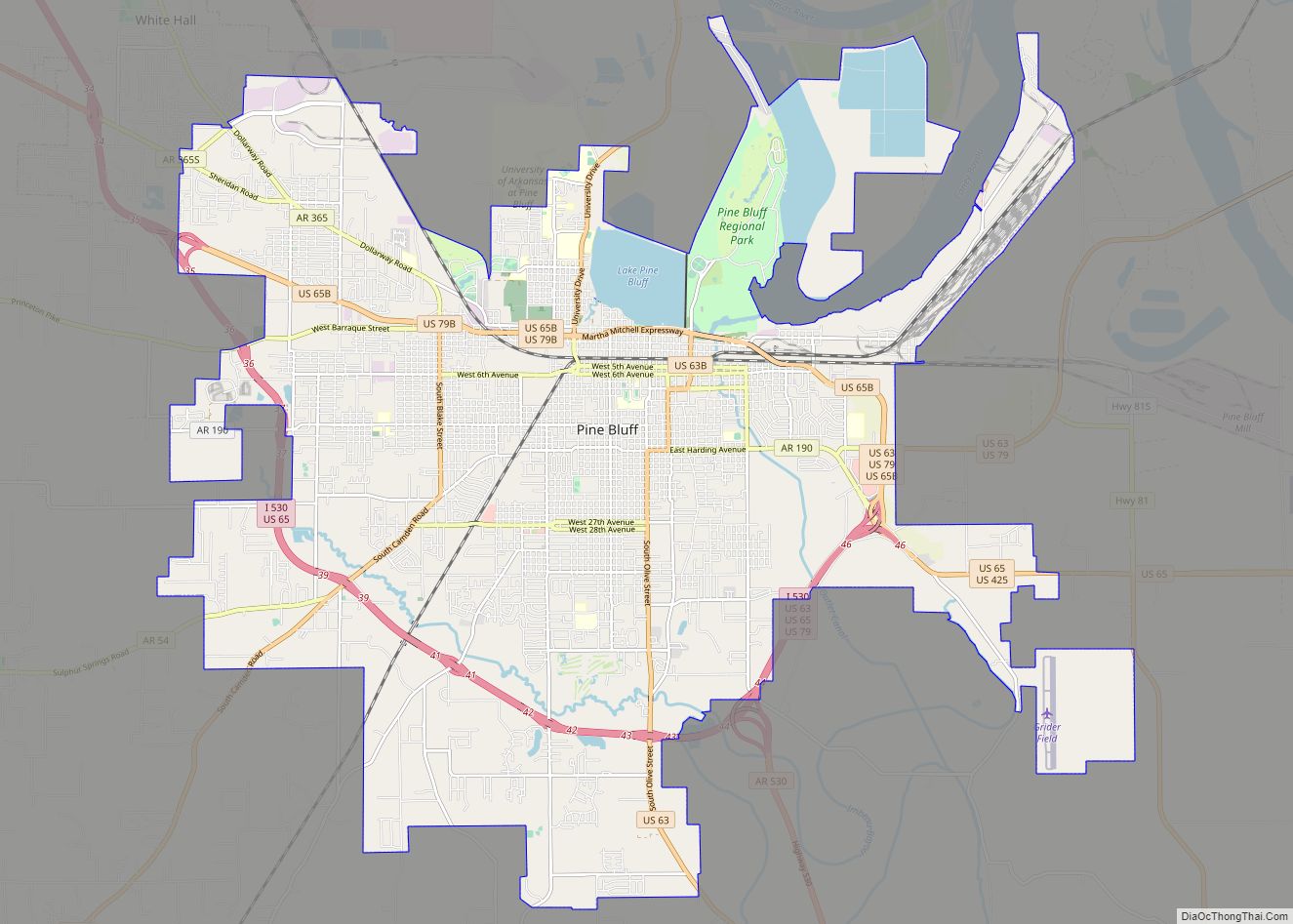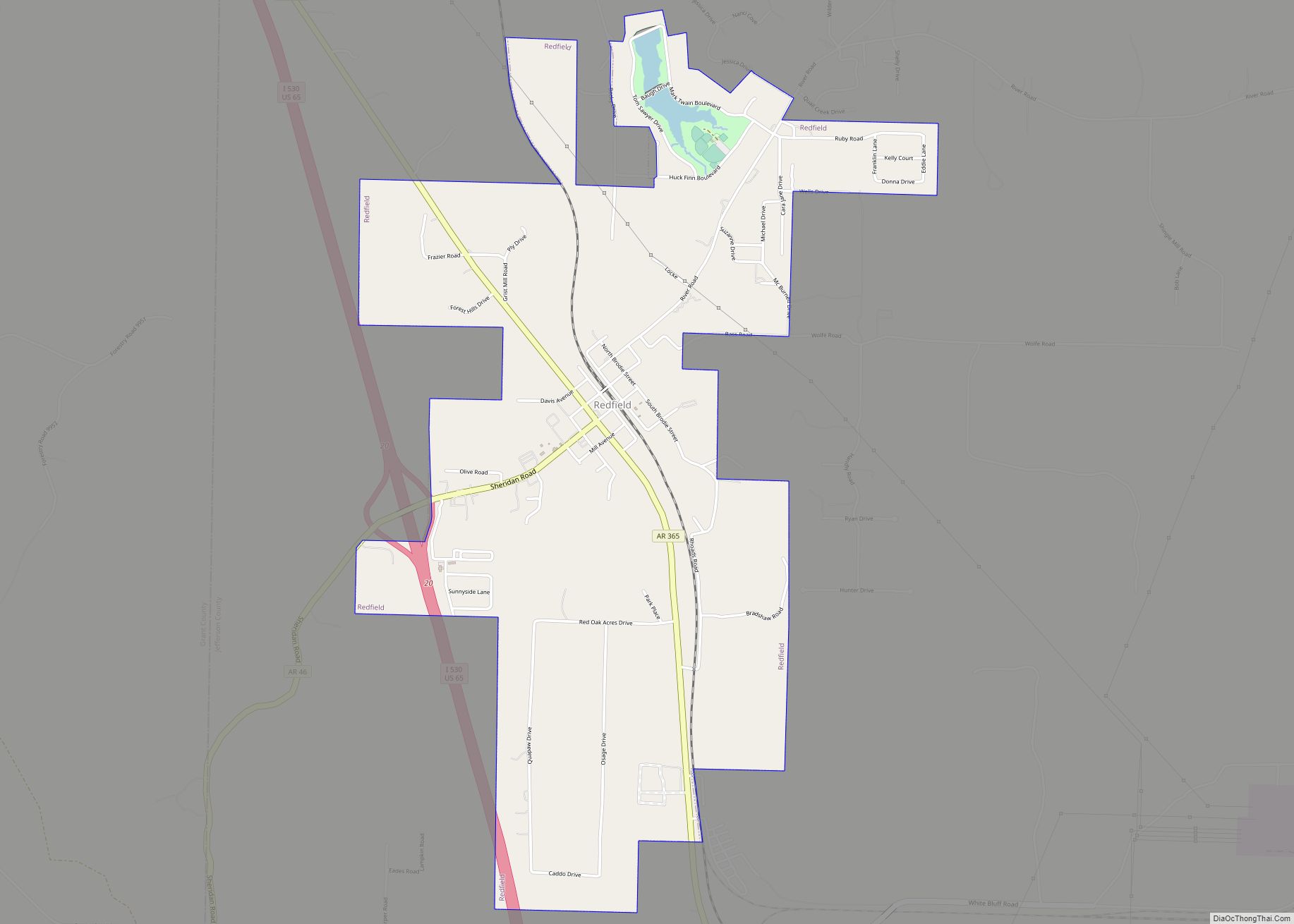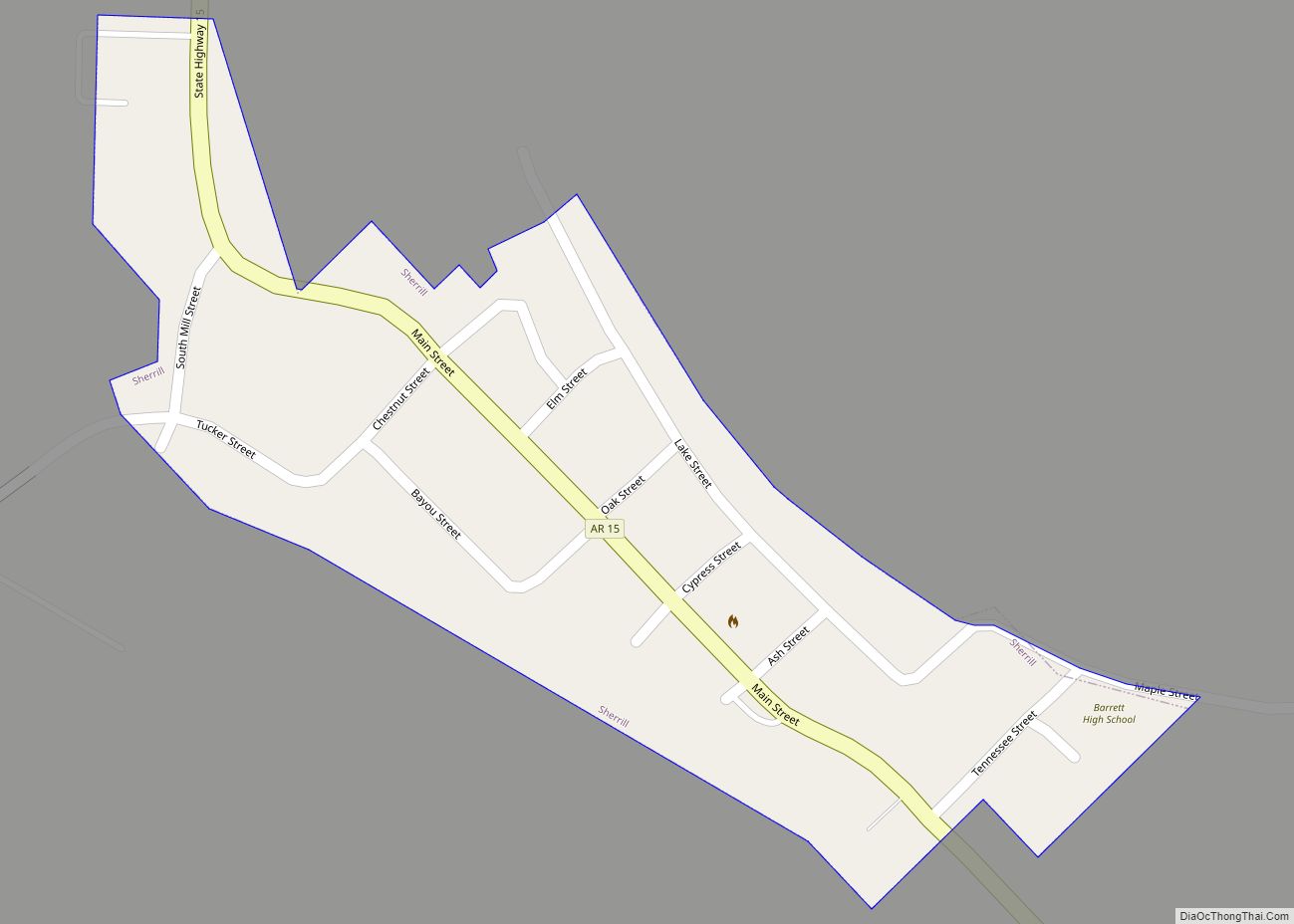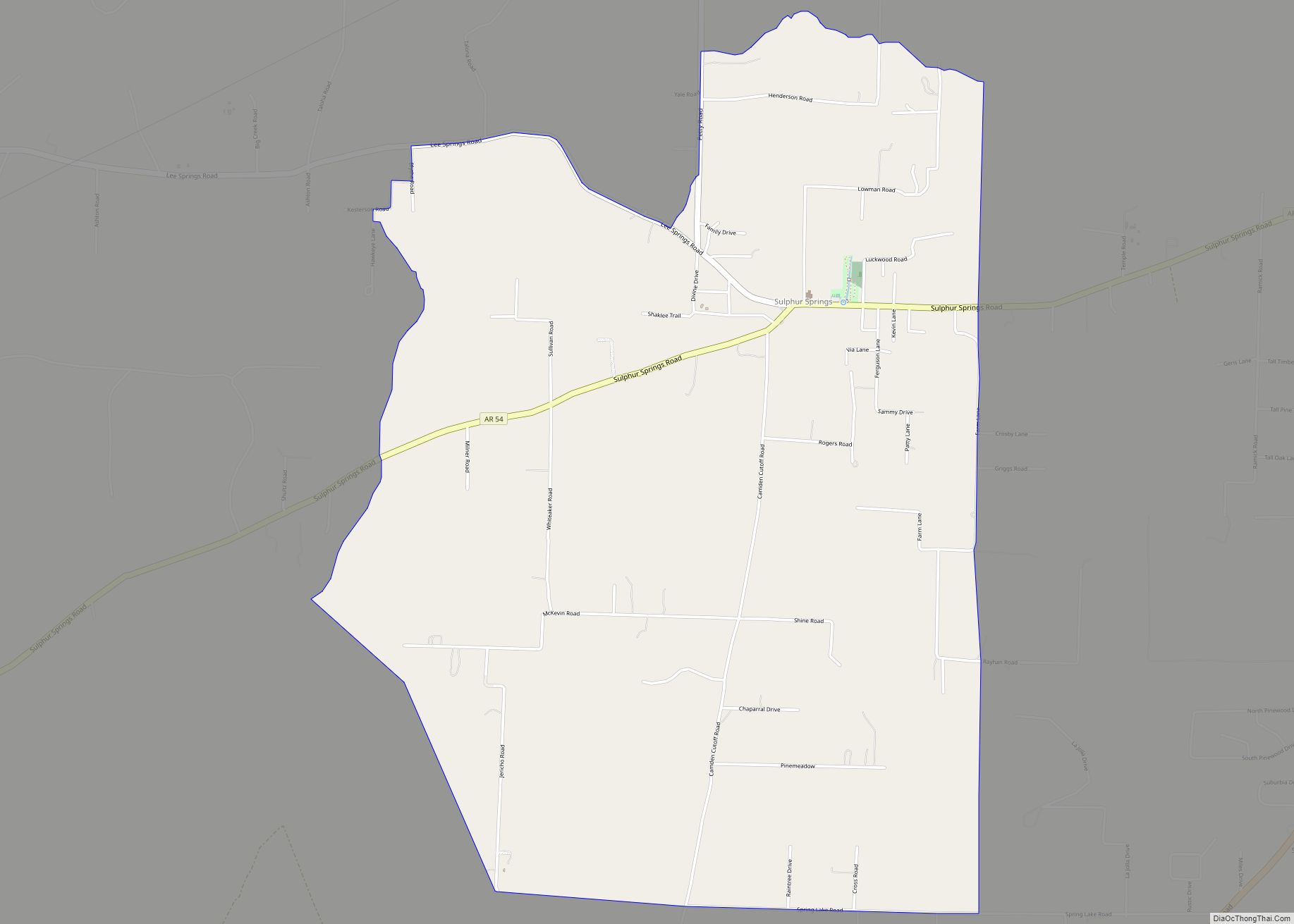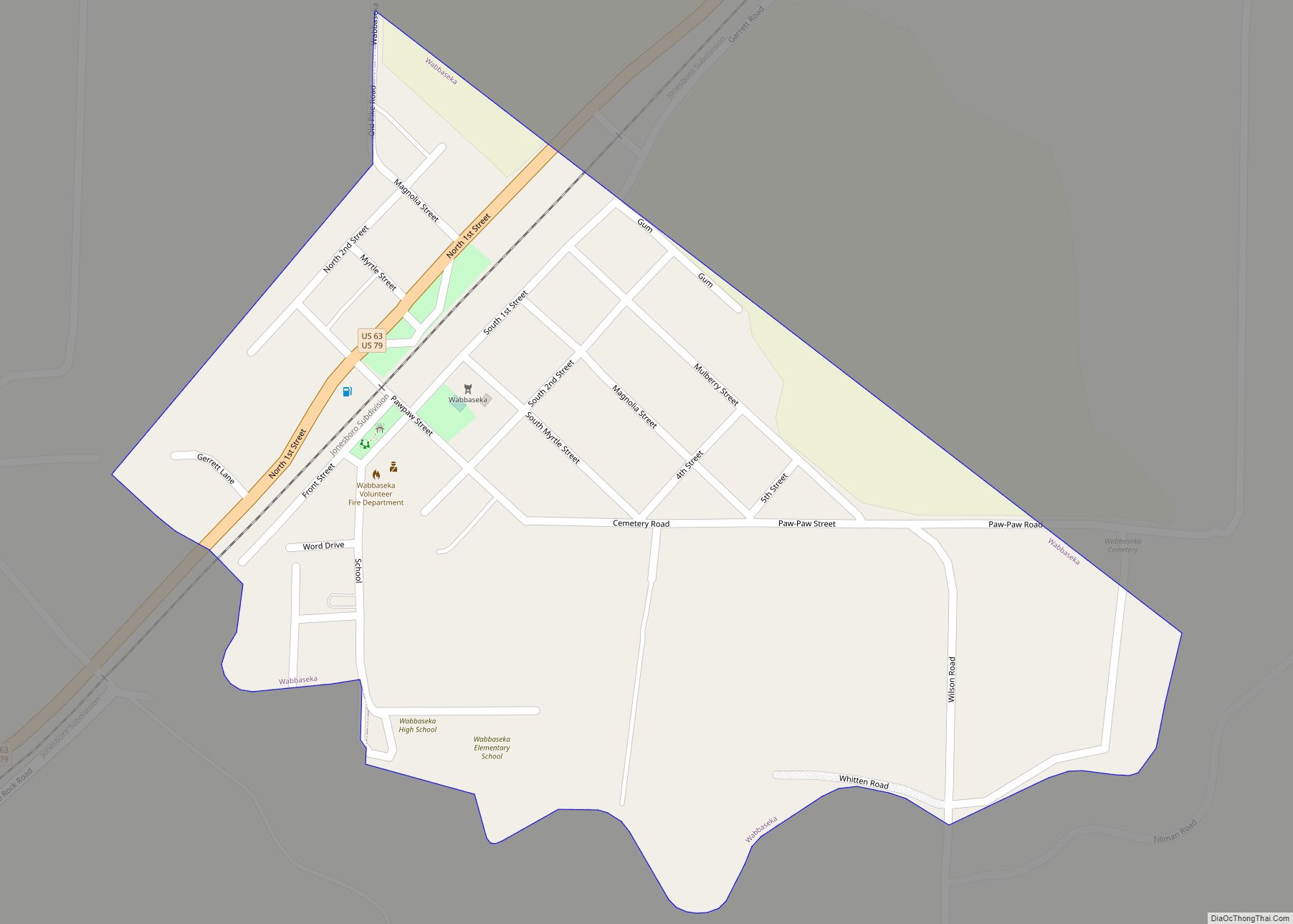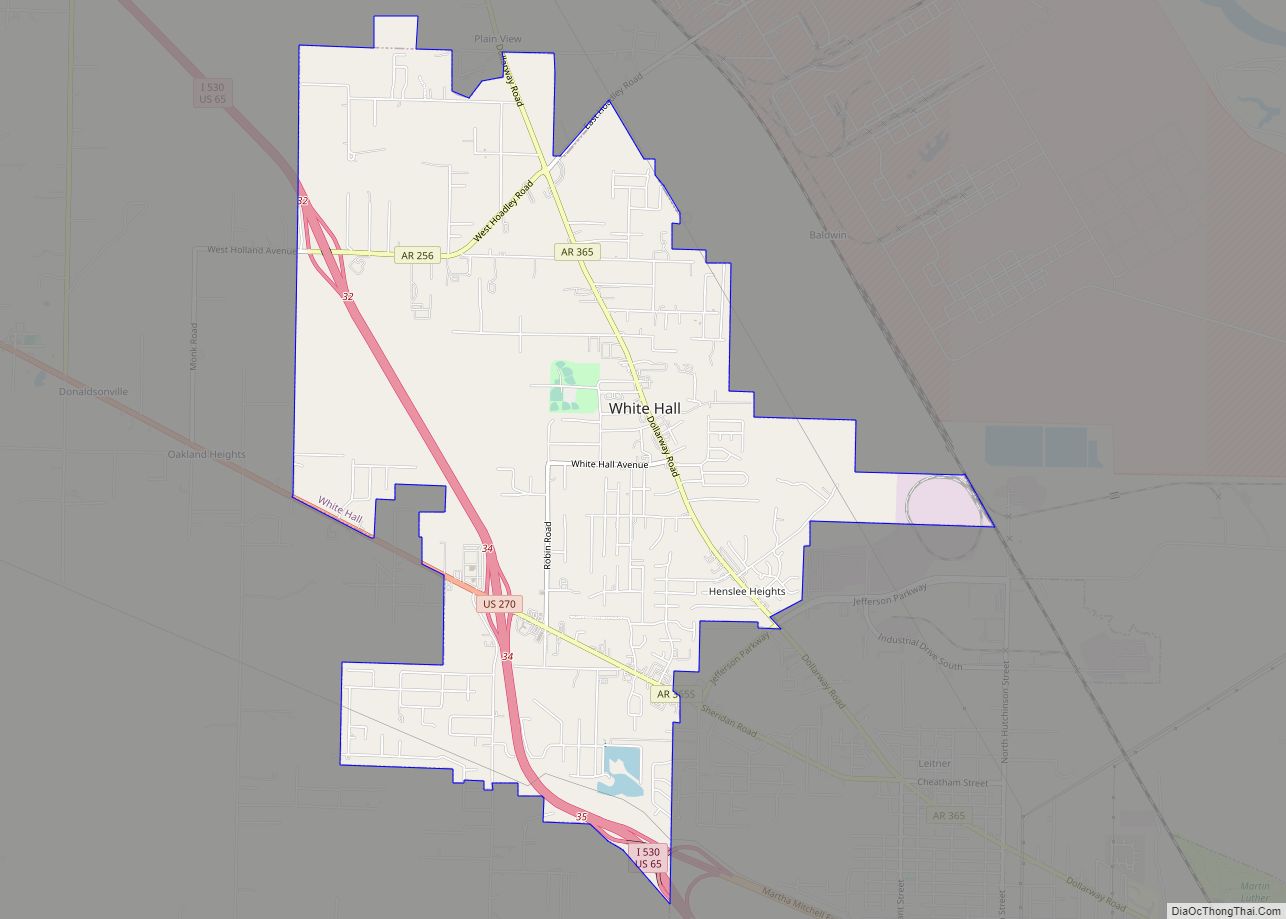Pine Bluff is the eleventh-largest city in the state of Arkansas and the county seat of Jefferson County. It is the principal city of the Pine Bluff Metropolitan Statistical Area and part of the Little Rock–North Little Rock-Pine Bluff Combined Statistical Area. The population of the city was 49,083 in the 2010 Census with 2019 estimates showing a decline to 41,474.
The city is situated in the Southeast section of the Arkansas Delta and straddles the Arkansas Timberlands region to its west. Its topography is flat with wide expanses of farmland, similar to other places in the Delta Lowlands. Pine Bluff has numerous creeks, streams, and bayous, including Bayou Bartholomew, the longest bayou in the world and the second most ecologically diverse stream in the United States. Large bodies of water include Lake Pine Bluff, Lake Langhofer (Slack Water Harbor), and the Arkansas River.
| Name: | Pine Bluff city |
|---|---|
| LSAD Code: | 25 |
| LSAD Description: | city (suffix) |
| State: | Arkansas |
| County: | Jefferson County |
| Incorporated: | January 8, 1839(184 years ago) (1839-01-08) |
| Elevation: | 220 ft (67 m) |
| Land Area: | 44.18 sq mi (114.43 km²) |
| Water Area: | 2.20 sq mi (5.69 km²) |
| Population Density: | 933.71/sq mi (360.50/km²) |
| Area code: | 870 |
| FIPS code: | 0555310 |
| GNISfeature ID: | 78006 |
Online Interactive Map
Click on ![]() to view map in "full screen" mode.
to view map in "full screen" mode.
Pine Bluff location map. Where is Pine Bluff city?
History
Pre-Columbian era to colonial era
The area along the Arkansas River had been inhabited for thousands of years by indigenous peoples of various cultures. They used the river for transportation as did European settlers after them, and for fishing. By the time of encounter with Europeans, the historical Quapaw were the chief people in the area, having migrated from the Ohio River valley centuries before.
The city of Pine Bluff was founded on a high bank of the Arkansas River heavily forested with tall pine trees. The high ground furnished settlers a safe haven from annual flooding. Joseph Bonne, a Métis fur trader and trapper of mixed Quapaw and colonial French ancestry, settled on this bluff in 1819.
1824–1860: Antebellum era
After the Quapaw signed a treaty with the United States in 1824 relinquishing their title to all the lands which they claimed in Arkansas, many other American settlers began to join Bonne on the bluff. In 1829 Thomas Phillips claimed a half section of land where Pine Bluff is located. Jefferson County was established by the Territorial Legislature on November 2, 1829, and began functioning as a county April 19, 1830.
At the August 13, 1832, county election, the pine bluff settlement was chosen as the county seat. The Quorum Court voted to name the village “Pine Bluff Town” on October 16, 1832. Pine Bluff was incorporated January 8, 1839, by the order of County Judge Taylor. At the time, the village had about 50 residents. Improved transportation aided in the growth of Pine Bluff during the 1840s and 1850s.
With its proximity to the Arkansas River, the small town served as a port for travel and shipping. Steamships provided the primary mode of transport, arriving from downriver ports such as New Orleans. From 1832–1838, Pine Bluff residents would see Native American migrants on the Trail of Tears waterway who were being forcibly removed by the US Army from the American Southeast to Indian Territory west of the Mississippi River.
From 1832–1858, Pine Bluff was also a station on the passage of Seminole and Black Seminoles, who were forcibly removed from Florida to the Territory. They included the legendary Black Seminole leader John Horse, who arrived in the city via the steamboat Swan in 1842.
1861–1900: Civil War, Reconstruction and beyond
Pine Bluff was prospering by the outbreak of the Civil War; most of its wealth was based on the commodity crop of cotton. This was cultivated on large plantations by hundreds of thousands of enslaved Africans throughout the state, but especially in the Delta. The city had one of the largest slave populations in the state by 1860, and Jefferson County, Arkansas was second in cotton production in the state. When Union forces occupied Little Rock, a group of Pine Bluff residents asked commanding Major General Frederick Steele to send Union forces to occupy their town to protect them from bands of Confederate bushwhackers. Union troops under Colonel Powell Clayton arrived September 17, 1863 and stayed until the war was over.
Confederate General J.S. Marmaduke tried to expel the Union Army in the Battle of Pine Bluff October 25, 1863, but was repulsed by a combined effort of soldiers and freedmen (former slaves freed by the Emancipation Proclamation). In the final year of the war, the 1st Regiment Kansas Volunteer Infantry (Colored) (composed primarily of escaped slaves from Arkansas and Missouri), was the first African-American regiment in the civil war to go into combat. It was dispatched to guard Pine Bluff and was eventually mustered out there.
Because of the Union forces, Pine Bluff attracted many refugees and freedmen after the Emancipation Proclamation was issued in early 1863. The Union forces set up a contraband camp there to house the runaway slaves and refugees behind Confederate lines. After the war, freed slaves worked with the American Missionary Association to start schools for the education of blacks, who had been prohibited from learning to read and write by southern laws. Both adults and children eagerly started learning. By September 1872, Professor Joseph C. Corbin opened the Branch Normal School of the Arkansas Industrial University, a historically black college. Founded as Arkansas’s first black public college, today it is the University of Arkansas at Pine Bluff.
Pine Bluff and the region suffered lasting effects from defeat, the aftermath of war, and the trauma of slavery and exploitation. Recovery was slow at first. Construction of railroads improved access to markets, and with increased production of cotton as more plantations were reactivated, the economy began to recover. The first railroad reached Pine Bluff in December 1873. This same year Pine Bluff’s first utility was formed when Pine Bluff Gas Company began furnishing manufactured gas from coke fuel for lighting purposes. The state’s economy remained highly dependent on cotton and agriculture, which suffered a decline through the 19th century.
As personal fortunes increased from the 1870s onward, community leaders constructed large Victorian-style homes west of Main Street. Meanwhile, the Reconstruction era of the 1870s brought a stark mix of progress and challenge for African Americans. Most blacks joined the Republican Party, and several were elected in Pine Bluff to county offices and the state legislature for the first time in history. Several black-owned businesses were also opened, including banks, bars, barbershops, and other establishments. But in postwar violence in 1866, an altercation with whites ensued at a refugee camp, and 24 black men, women and children were found hanging from trees in one of the worst mass lynchings in U.S. history.
The rate of lynchings of black males was high across the South during this period of social tensions and white resistance to Reconstruction. Armistad Johnson was lynched in 1889, and John Kelly and Gulbert Harris in 1892 in front of the Jefferson County Courthouse, after a mob of hundreds rapidly escalated to thousands of whites vehemently demanding execution, despite Kelly’s pleas of innocence and lack of trial. The angry mob eventually forced over his custody from an Officer adamantly attempting to deliver the suspect to the jail house, then the crowd watched enthusiastically as he was hung and riddled with bullets. That same year the state adopted a poll tax amendment that disenfranchised many African-American and poor white voters. The Election Law of 1891 had already made voting more difficult and also caused voter rolls to decrease. With the Democratic Party consolidating its power in what became a one-party state, the atmosphere was grim toward the end of the 19th century for many African Americans. Democrats imposed legal segregation and other Jim Crow laws.
Bishop Henry McNeal Turner’s “Back to Africa” movement attracted numbers of local African-American residents who purchased tickets and/or sought information on emigration (Arkansas had 650 emigrants depart to the colony of Liberia in West Africa; more than from any other state in the United States. The majority of these emigrants came from the black-majority Jefferson, St. Francis, Pulaski, Pope, and Conway counties.
According to historian James Leslie, Pine Bluff entered its “Golden Era” in the 1880s. Cotton production and river commerce helped the city draw industries, public institutions and residents to the area, making it by 1890 the state’s third-largest city. The first telephone system was placed in service March 31, 1883. Wiley Jones, a freedman who achieved wealth by his own business, built the first mule-drawn, street-car line in October 1886. The first light, power and water plant was completed in 1887; a more dependable light and water system was put in place in 1912. Throughout the 1880s and 1890s, economic expansion was also fueled by the growing lumber industry in the region.
1900–1941: 1900 through the Great Depression
Situated on the Arkansas River, Pine Bluff depended on river traffic and trade. Community leaders were concerned that the main channel would leave the city. The United States Army Corps of Engineers built a levee opposite Pine Bluff to try to keep the river flowing by the city.
During a later flood, the main channel of the river moved away from the city, leaving a small oxbow lake (later expanded into Lake Pine Bluff). River traffic diminished, even as the river was a barrier separating one part of the county from the other. After many years of regional haggling, because the bond issue involved raised taxes, the county built the Free Bridge, which opened in 1914. For the first time, it united the county on a permanent basis.
African Americans in Pine Bluff were damaged by the state’s disfranchisement in 1891–1892 and exclusion from the political system. But they continued to work for their rights; they joined activists in Little Rock and Hot Springs in a sustained boycott of streetcars, protesting passage in 1903 of the Segregated Streetcar Act, part of a series of Jim Crow laws passed by the white-dominated legislature. They did not achieve change then.
Development in the city’s business district grew rapidly. The Masonic Lodge, built by and for the African-American chapter in the city, was the tallest building in Pine Bluff when completed in 1904. The Hotel Pines, constructed in 1912, had an intricate marble interior and classical design, and was considered one of Arkansas’ showcase hotels. The 1,500-seat Saenger Theater, built in 1924, was one of the largest such facilities in the state; it operated the state’s largest pipe organ. When Dollarway Road was completed in 1914, it was the longest continuous stretch of concrete road in the United States. The first radio station (WOK) broadcast in Arkansas occurred in Pine Bluff on February 18, 1922.
Two natural disasters had devastating effects on the area’s economy. The first was the Great Flood of 1927, a 100-year flood. Due to levee breaks, most of northern and southeastern Jefferson County were flooded. The severe drought of 1930 caused another failure of crops, adding to the problems of economic conditions during the Great Depression. Pine Bluff residents scrambled to survive. In 1930, two of the larger banks failed.
The state’s highway construction program in the later 1920s and early 1930s, facilitating trade between Pine Bluff and other communities throughout southeast Arkansas, was critical to Jefferson County, too. After the inauguration of President Franklin D. Roosevelt in 1933, he launched many government programs to benefit local communities. Through the Works Progress Administration (WPA) and public works funding, Pine Bluff built new schools and a football stadium, and developed Oakland Park as its first major recreation facility. To encourage diversification in agriculture, the county built a stockyard in 1936 to serve as a sales outlet for farmers’ livestock.
From 1936–1938, the WPA through the Federal Writers Project initiated a project to collect and publish oral histories of former slaves. Writers were sent throughout the South to interview former slaves, most of whom had been children before the Civil War. When the project was complete, Arkansas residents had contributed more oral slave histories (approximately 780) than any other state, although Arkansas’ slave population was less than those of neighboring Deep South states. African-American residents of Pine Bluff/Jefferson County contributed more oral interviews of Arkansas-born slaves than any other city/county in the state. The city served to compile a valuable storehouse of oral slave narrative material.
During the 1933 Mississippi River flood, country singer Johnny Cash evacuated to Pine Bluff.
1941–1960: World War II and economic diversification
World War II brought profound changes to Pine Bluff and its agriculture, timber and railroad-oriented economy. The Army built Grider Field Airport which housed the Pine Bluff School of Aviation and furnished flight training for air cadets for the Army Air Corps. At one time 275 aircraft were being used to train 758 pilots. Approximately 9,000 pilots had been trained by the time the school closed in October 1944.
The Army broke ground for the Pine Bluff Arsenal on December 2, 1941, on 15,000 acres (61 km) bought north of the city. The arsenal and Grider Field changed Pine Bluff to a more diversified economy with a mixture of industry and agriculture. The addition of small companies to the industrial base helped the economy remain steady in the late 1940s. Defense spending in association with the Korean War was a stabilizing factor after 1950.
In 1957, Richard Anderson announced the construction of a kraft paper mill north of the city. International Paper Co. shortly afterward bought a plant site five miles east of Pine Bluff. Residential developments followed for expected workers. The next year young minister Martin Luther King Jr. addressed students at the commencement program for Arkansas AM&N College (now the University of Arkansas at Pine Bluff).
1960–present: The modern era
The decade of the 1960s brought heightened activism in the civil rights movement: through boycotts and demonstrations, African Americans demanded an end to segregated public facilities and jobs. Some whites responded with violence, attacking demonstrators, and bombing a black church in Pine Bluff in 1963. Some civil rights demonstrators were shot. Local leaders worked tirelessly, at times enlisting the support of national figures such as Dick Gregory and Stokely Carmichael, to help bring about change over the period. Voter registration drives that enabled increased black political participation, selective buying campaigns, student protests, and a desire among white local business leaders to avoid damaging negative media portrayals in the national media led to reforms in public accommodations.
During the 1960s and 1970s, major construction projects in the region included private and public sponsors: Jefferson Hospital (now Jefferson Regional Medical Center), the dams of the McClellan-Kerr Navigation System on the Arkansas River (which was diverted from the city to create Lake Langhofer), a Federal building, the Pine Bluff Convention Center complex including The Royal Arkansas Hotel & Suites, Pine Bluff Regional Park, two industrial parks and several large churches.
The 1980s and 1990s brought a number of significant construction projects. Benny Scallion Park was created, named for the alderman who brought a Japanese garden to the Pine Bluff Civic Center. The city has not maintained the garden, but a small plaque remains. In the late 1980s, The Pines, the first large, enclosed shopping center, was constructed on the east side of the city. The mall attracted increased shopping traffic from southeast Arkansas.
The most important construction project of the 1990s was completion of a southern bypass, designated part of Interstate 530. In addition, a highway and bridge across Lock and Dam #4 were completed, providing another link between farm areas in northeastern Jefferson County and the transportation system radiating from Pine Bluff. Through a private matching grant, a multimillion-dollar Arts and Science Center for Southeast Arkansas was completed downtown in 1994.
In 2000, construction was completed on the 43,000-square-foot (4,000 m) Donald W. Reynolds Community Services Center. Carl Redus became the first African American mayor in the city’s history in 2005. The University of Arkansas at Pine Bluff recently opened a $3 million business incubator in downtown Pine Bluff. Also, a new $2 million farmers market pavilion was opened in 2010 on Lake Pine Bluff in downtown Pine Bluff.
Shirley Washington is the first female African American mayor. She was elected in 2016.
Beginning around 2020, Utah based entrepreneur John Fenley, owner of the music streaming service Murfie, began buying properties in Pine Bluff for redevelopment.
Pine Bluff Road Map
Pine Bluff city Satellite Map
Geography
Pine Bluff is on the Arkansas River; the community was named for a bluff along that river. Both Lake Pine Bluff and Lake Langhofer are situated within the city limits, as these are bodies of water which are remnants of the historical Arkansas River channel. (The former is a man-made expansion of a natural oxbow; the latter was created by diking the old channel after a man-made diversion.) Consequently, the Mississippi Alluvial Plain (or the Arkansas Delta) runs well into the city with Bayou Bartholomew picking up the western border as a line of demarcation between the Arkansas Delta and the Arkansas Timberlands.
A series of levees and dams surrounds the area to provide for flood control and protect from channel shift. One of the world’s longest individual levees at 380 miles runs from Pine Bluff to Venice, Louisiana.
Metropolitan statistical area
Pine Bluff is the largest city in a three-county MSA as defined by the U.S. Census Bureau including Jefferson, Cleveland, and Lincoln counties. The Pine Bluff MSA population in 2000 was 107,341 people. The Pine Bluff MSA population in 2007 dropped to 101,484. Pine Bluff was the fastest-declining Arkansas MSA from 2000–2007. The Pine Bluff area is also a component of the Little Rock-North Little Rock-Pine Bluff Combined Statistical Area which had a population of 902,443 people in the 2014 U.S. census estimate.
Climate
According to the United States Census Bureau, the city has a total area of 46.8 square miles (121 km), of which 45.6 square miles (118 km) is land and 1.2 square miles (3.1 km) (2.65%) is water.
See also
Map of Arkansas State and its subdivision:- Arkansas
- Ashley
- Baxter
- Benton
- Boone
- Bradley
- Calhoun
- Carroll
- Chicot
- Clark
- Clay
- Cleburne
- Cleveland
- Columbia
- Conway
- Craighead
- Crawford
- Crittenden
- Cross
- Dallas
- Desha
- Drew
- Faulkner
- Franklin
- Fulton
- Garland
- Grant
- Greene
- Hempstead
- Hot Spring
- Howard
- Independence
- Izard
- Jackson
- Jefferson
- Johnson
- Lafayette
- Lawrence
- Lee
- Lincoln
- Little River
- Logan
- Lonoke
- Madison
- Marion
- Miller
- Mississippi
- Monroe
- Montgomery
- Nevada
- Newton
- Ouachita
- Perry
- Phillips
- Pike
- Poinsett
- Polk
- Pope
- Prairie
- Pulaski
- Randolph
- Saint Francis
- Saline
- Scott
- Searcy
- Sebastian
- Sevier
- Sharp
- Stone
- Union
- Van Buren
- Washington
- White
- Woodruff
- Yell
- Alabama
- Alaska
- Arizona
- Arkansas
- California
- Colorado
- Connecticut
- Delaware
- District of Columbia
- Florida
- Georgia
- Hawaii
- Idaho
- Illinois
- Indiana
- Iowa
- Kansas
- Kentucky
- Louisiana
- Maine
- Maryland
- Massachusetts
- Michigan
- Minnesota
- Mississippi
- Missouri
- Montana
- Nebraska
- Nevada
- New Hampshire
- New Jersey
- New Mexico
- New York
- North Carolina
- North Dakota
- Ohio
- Oklahoma
- Oregon
- Pennsylvania
- Rhode Island
- South Carolina
- South Dakota
- Tennessee
- Texas
- Utah
- Vermont
- Virginia
- Washington
- West Virginia
- Wisconsin
- Wyoming
